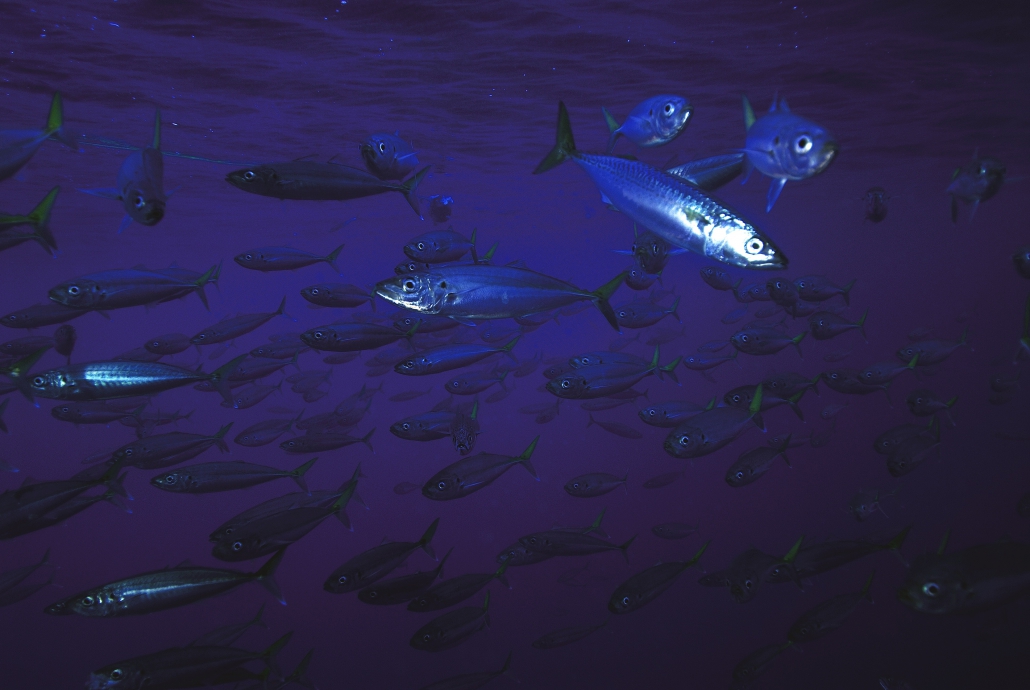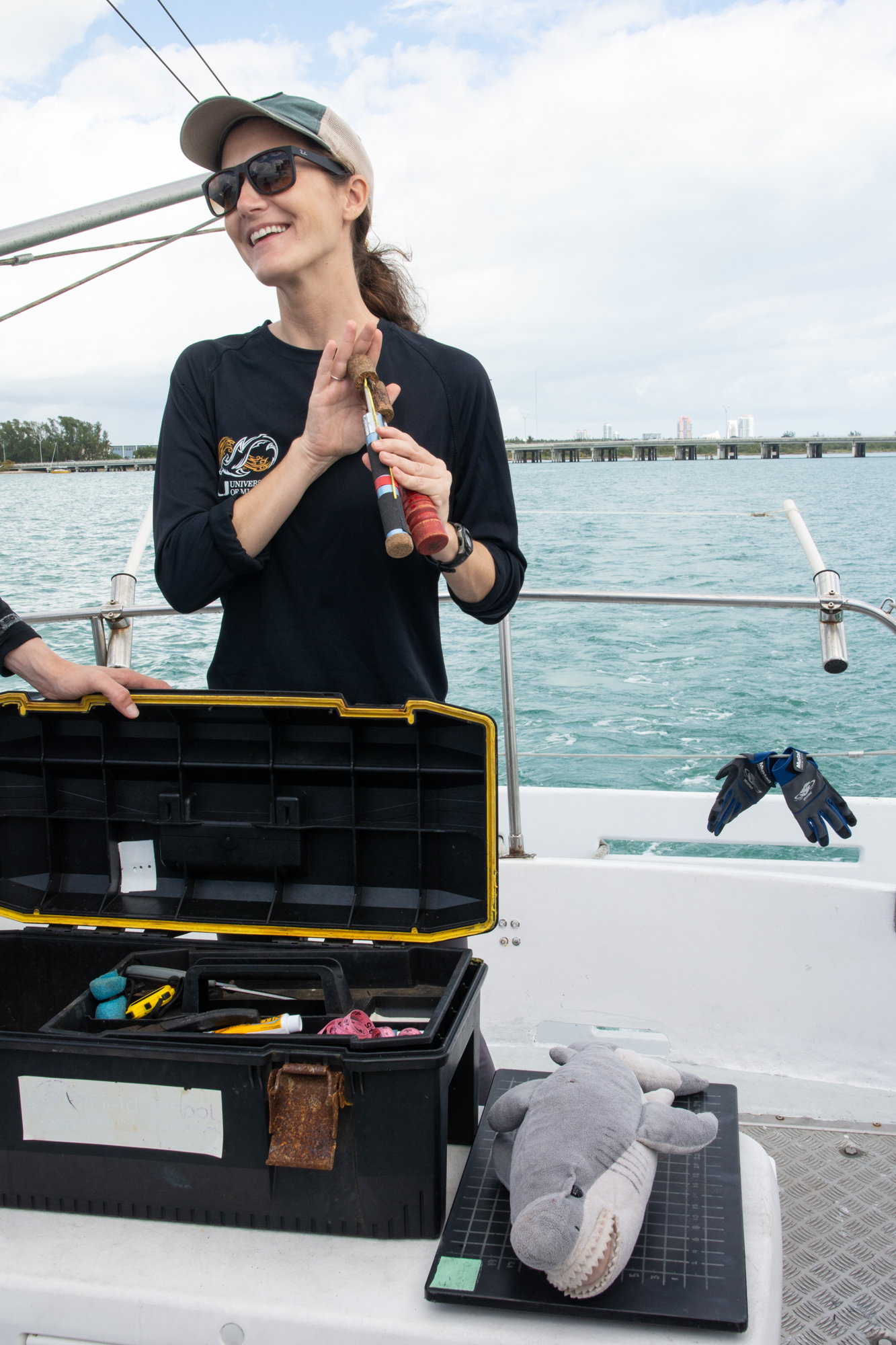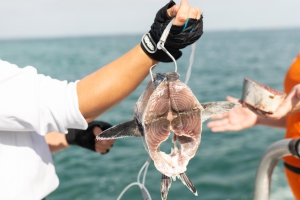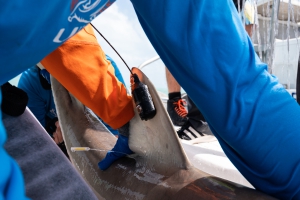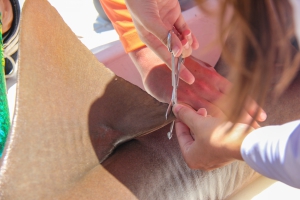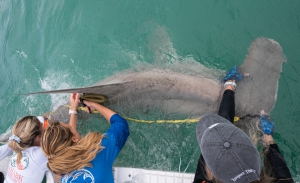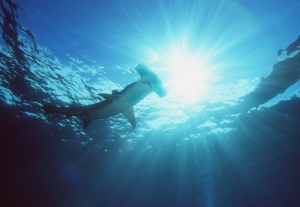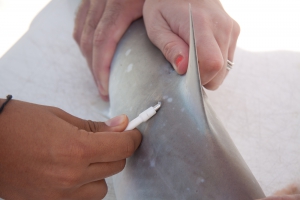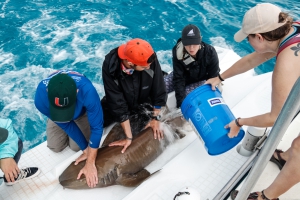Drumlines and Circle Hooks
We use custom-designed fishing units called drumlines to reduce shark capture stress and promote their well-being. Each drumline is affixed with a long fishing line, composed of a series of swivels, to allow hooked sharks to swim with 360 degrees’ range of motion. This allows for the shark to continue swimming in large circles for ram ventilation (many shark species need to continuously swim to provide oxygenated water flow over their gills). We also use circle hooks which do not harm the sharks, acting to reduce potential incidence of deep hooking, and also allow for easy hook removal.
Hook Timer
Each drumline has a timer attached, which records how long each shark has been on the line. With this data, we can better gauge fish stress levels, and adjust our tagging procedure accordingly.
Water Pump
If the shark is brought aboard for tagging and sampling, a water pump is placed in its mouth that pushes fresh ocean water over its gills. This allows for continued breathing, and reduced stress levels.
Blood Sample
We collect a small blood sample from each shark, which can reveal a wealth of information. These samples help us assess stress levels, pregnancy hormones, immune status, energy stores, and short-term dietary patterns of sharks. Similar to having your blood drawn at the doctor’s office, a sterile needle is inserted into the caudal vein of the shark to collect a few milliliters of blood in a matter of seconds.
Satellite Tags
Utilizing the latest satellite tag technology, we can gather invaluable data without compromising the health of any shark. The satellite tags are carefully attached to the dorsal fins of sharks with the utmost consideration to shark health and safety. This attachment doesn’t hurt the shark are designed to eventually fall off the fin. We’ve recaptured satellite tagged sharks after months at liberty, and their fins are undamaged.
Fin clip
Part of our workup includes sampling a small piece of dorsal fin tissue. This doesn’t hurt the shark as their fin is composed mainly of cartilage and protein rays, lacking the pain receptors that mammals have. Additionally, the small piece of tissue can regenerate. We use these fin clips as part of a larger study investigating population genetics of wild caught sharks, toxicity of their tissues, and to explore long-term dietary trends.
Sonogram
During special expeditions, sharks will be quickly and painlessly inspected via sonogram for pregnancy. This is a cutting-edge, non-lethal method for studying shark reproduction.
Rapid Processing Time
To minimize stress to the sharks, our team works like a race car pit crew to quickly tag and sample the shark before releasing it back into the ocean. We keep track of how long we’ve been working up a shark and know the importance of returning the animal to the water quickly. We prioritize the health of the animal over gathering all our data.
Monitoring Release Condition
We monitor the shark’s condition upon release to help gauge the efficacy of our stress-reducing efforts. Taking underwater photo and video allows for later scientific review. We make sure each shark swims off healthy and strong, even if that means spending time in the water to monitor the shark through videos and photos.
Muscle biopsy
part of our workup includes taking a small muscle biopsy from each shark. A small incision is made with a sterile scalpel and a specialized biopsy punch is used to collect a minute amount of muscle. These samples provide a wealth of information about toxin levels, immune sate and nutritional condition of sharks over longer time periods.
Water Shower
The lab recently published work that investigated thermal body scans of wild caught sharks. We found that sharks can heat up rapidly when out of the water—this makes sense when you consider that water disperses heat faster. To prevent the sharks from overheating during workups we routinely pour cool saltwater over the shark them.
Great Hammerheads
One of the key species we work with is the great hammerhead shark. Our previous research has demonstrated that hammerheads are vulnerable to capture stress. When working with hammerheads, we have a significantly abridged, specially modified, in-water procedure to ensure their rapid release. The health and welfare of these animals is our priority, and we will not collect data from a shark if it is exhibiting symptoms of high stress.
Acoustic tags
We deploy external acoustic tags on great hammerhead sharks. Like our other tags they are not permanent, but they can provide us with several years of data. Each tag emits a unique high frequency signal (that cannot be heard by the shark) which is recorded on our underwater hydrophones. We take special care to place these tags through the dorsal fin at an angle that they will not rub against the shark and cause irritation.
FAQs
Does your research harm the sharks?
Every aspect of our data gathering process is designed to minimize harm to our research subjects. We use special fishing and tagging gear intended to reduce stress, shorten handling time and promote shark safety.
Drumlines
The Shark Research & Conservation Program uses special fishing units called drumlines (composed of a single weight and attached hook & line) that promotes shark vitality when fishing for sharks. The gear permits species which are ram ventilaters (need to keep moving to breathe) to swim in big circles around the weight when caught. The ability to swim relatively freely also minimizes stress-related C02 and lactic acid buildup in shark muscle. This gear promotes shark survival.
Circle hooks
Circle hooks can help reduce negative outcomes for captured sharks over other commonly used hooks, most notably J hooks. Circle hooks are designed to catch in the shark’s jaw, instead of catching on the shark’s stomach or gills, which can otherwise cause serious injury. The hooks can also easily be removed from the jaw and leave a very superficial wound that heals very quickly. Circle hooks also help us selectively target sharks, reducing unwanted bycatch of other species. We recommend circle hooks not only for research-related capture, but for recreational fishermen practicing catch and release fishing who want to increase the likelihood of release their catches in good condition.
Workup Process
When a caught shark is brought onto a specialized, partly-submerged, platform on the back of our research vessel, a saltwater pump is immediately placed in the sharks’ mouth. This allows highly oxygenated water to flow over its gills throughout the shark’s brief ”check-up.” During this workup, sharks have a small muscle biopsy taken (recaptured sharks demonstrate that the biopsy site is completely healed within just a few weeks), are tagged with a spaghetti tag in their dorsal fin (where they have no nerve endings and no blood vessels), have blood drawn, are measured, have a small clip of their fin cartilage taken, and are released.
The traditional method for getting the type of data we collect was to kill the animals. Although capture may still be a relatively stressful process for sharks, our work focuses on minimizing shark stress to the greatest extent possible and promoting shark vitality and survival.
Do sharks feel pain when you work them up?
Sharks have significantly fewer nerve endings than humans do. Humans have developed tremendously complex nervous systems with many millions of nerves as part of the process of evolution, these nerves “teach” us—through pain—what we should and shouldn’t do (don’t touch a hot stove). However, this level of sensitivity to temperature, pressure or pain has not been necessary for sharks. The nerves that report tissue damage and lead us to feel “pain” are neurons called “nociceptors” which account for approximately 50 percent of all human neurons, but only 13 to 38 percent of shark neurons and less than 1 percent of ray neurons. Sharks have many fewer nerves than we do, and devote a smaller percentage of those they do have to feeling pain. Therefore, although we don’t know exactly how it feels to a shark when we tag it, we can say for certain that they have neither the nerve endings nor the neurological apparatus to experience pain the way a human would.
For more information on sharks and pain, please click HERE.
Do your tags cause fin damage?
All tags are not permanent. They fall off over time and the application point heals back quickly. Some of our satellite tags are temporarily attached to the shark’s dorsal fin. However, sharks have no blood or nerve supply to their fins. We’ve also recaptured satellite tagged sharks after months at liberty, and their fins appeared undamaged. The potential effects on the sharks are minimal considering the research and education it provides, which will help protect these threatened species. For more information, please read our paper on satellite tags, which also discuss the potential for negative impacts on sharks.
For a full description of the potential impacts of satellite tagging, visit Dr. Hammerschlag’s blog on National Geographic.
How does all this sampling and tagging actually help sharks?
In order to create the most effective policies to protect shark populations, scientists need to study the biology, ecology, and life history of these species. Sharks spend so much of their lives below the surface, away from humans, that very little is currently known about them. Dr. Hammerschlag and his team have developed some of the most cutting-edge and efficient methodologies for studying sharks, while still ensuring healthy release conditions. Explore our biggest discoveries in the scientific publications and surrounding media coverage.
How long can the shark stay out of the water?
We don’t fully remove sharks from the water. We use a specially designed platform that is partially submerged to secure the sharks. During their “check-ups”, we place a water pump in the shark’s mouth to pump oxygenated saltwater over their gills to promote vitality. The platform allows us to sample and tag the shark much quicker than if it were thrashing around in the water. Although we aim to release the sharks as quickly as possible, our check-ups usually last about five minutes on average before releasing the sharks.

